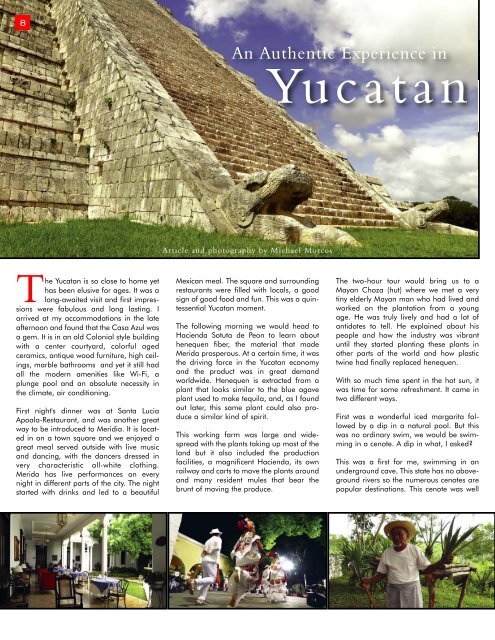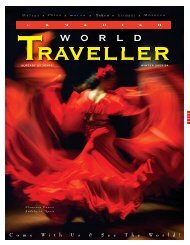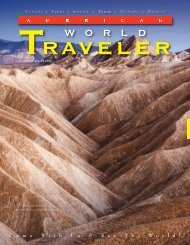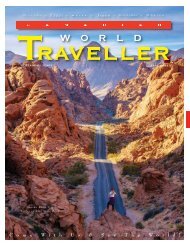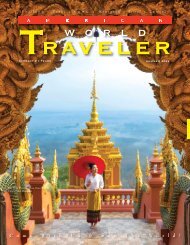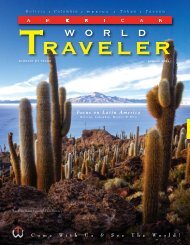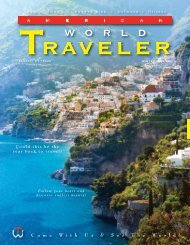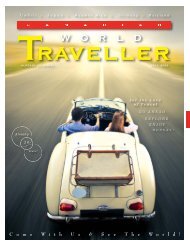Canadian World traveller Winter 2017-18 Issue
Now in our 15th year of publishing, Canadian World Traveller explores the culture and history of worldwide destinations, sharing the adventure of discovery with our readers and motivating them to make their travel dreams a reality. Published quarterly, CWT helps sophisticated, independent Canadian travellers choose their next destination by offering a lively blend of intelligent, informative articles and tantalizing photographic images from our World’s best destinations, cruises, accommodations and activities to suit every traveller's taste.
Now in our 15th year of publishing, Canadian World Traveller explores the culture and history of worldwide destinations, sharing the adventure of discovery with our readers and motivating them to make their travel dreams a reality. Published quarterly, CWT helps sophisticated, independent Canadian travellers choose their next destination by offering a lively blend of intelligent, informative articles and tantalizing photographic images from our World’s best destinations, cruises, accommodations and activities to suit every traveller's taste.
You also want an ePaper? Increase the reach of your titles
YUMPU automatically turns print PDFs into web optimized ePapers that Google loves.
8<br />
An Authentic Experience in<br />
Yucatan<br />
Article and photography by Michael Morcos<br />
The Yucatan is so close to home yet<br />
has been elusive for ages. It was a<br />
long-awaited visit and first impressions<br />
were fabulous and long lasting. I<br />
arrived at my accommodations in the late<br />
afternoon and found that the Casa Azul was<br />
a gem. It is in an old Colonial style building<br />
with a center courtyard, colorful aged<br />
ceramics, antique wood furniture, high ceilings,<br />
marble bathrooms and yet it still had<br />
all the modern amenities like Wi-Fi, a<br />
plunge pool and an absolute necessity in<br />
the climate, air conditioning.<br />
First night's dinner was at Santa Lucia<br />
Apoala-Restaurant, and was another great<br />
way to be introduced to Meridia. It is located<br />
in on a town square and we enjoyed a<br />
great meal served outside with live music<br />
and dancing, with the dancers dressed in<br />
very characteristic all-white clothing.<br />
Merida has live performances on every<br />
night in different parts of the city. The night<br />
started with drinks and led to a beautiful<br />
Mexican meal. The square and surrounding<br />
restaurants were filled with locals, a good<br />
sign of good food and fun. This was a quintessential<br />
Yucatan moment.<br />
The following morning we would head to<br />
Hacienda Sotuta de Peon to learn about<br />
henequen fiber, the material that made<br />
Merida prosperous. At a certain time, it was<br />
the driving force in the Yucatan economy<br />
and the product was in great demand<br />
worldwide. Henequen is extracted from a<br />
plant that looks similar to the blue agave<br />
plant used to make tequila, and, as I found<br />
out later, this same plant could also produce<br />
a similar kind of spirit.<br />
This working farm was large and widespread<br />
with the plants taking up most of the<br />
land but it also included the production<br />
facilities, a magnificent Hacienda, its own<br />
railway and carts to move the plants around<br />
and many resident mules that bear the<br />
brunt of moving the produce.<br />
The two-hour tour would bring us to a<br />
Mayan Choza (hut) where we met a very<br />
tiny elderly Mayan man who had lived and<br />
worked on the plantation from a young<br />
age. He was truly lively and had a lot of<br />
antidotes to tell. He explained about his<br />
people and how the industry was vibrant<br />
until they started planting these plants in<br />
other parts of the world and how plastic<br />
twine had finally replaced henequen.<br />
With so much time spent in the hot sun, it<br />
was time for some refreshment. It came in<br />
two different ways.<br />
First was a wonderful iced margarita followed<br />
by a dip in a natural pool. But this<br />
was no ordinary swim, we would be swimming<br />
in a cenote. A dip in what, I asked?<br />
This was a first for me, swimming in an<br />
underground cave. This state has no aboveground<br />
rivers so the numerous cenotes are<br />
popular destinations. This cenote was well


